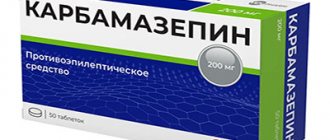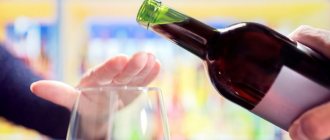Alcohol and alcoholism are a real social problem
Drinking alcohol has long been an integral part of social life for most people. The hard facts: per capita alcohol consumption in Russia is about 10 liters per year, and approximately 1% of the population suffers from alcohol dependence.
In some regions, excessive alcohol consumption is indirectly or directly responsible for a significant proportion of deaths. Large amounts of alcohol primarily affect the liver and gastrointestinal tract. Complications such as atherosclerosis, osteoporosis (bone fragility), vitamin deficiency, anemia, and malignant tumors also occur. In addition to diseases caused directly as a result of alcohol intoxication, fatal consequences include road accidents, suicides, and crimes committed while intoxicated.
How does alcoholism occur?
Alcohol entering the brain increases the concentration of certain neurotransmitters, such as dopamine and endorphin. They cause short-term pleasant feelings of intoxication - euphoria, relaxation, decreased anxiety - and lure a person into a trap. A psychological dependence is formed, forcing you to drink more and more.
Alcohol metabolism and consequences of abuse
Meanwhile, the body detoxifies the alcohol by turning it into acetaldehyde. The latter is always contained in the body, but in high concentrations it is a strong toxin. Therefore, with the help of the enzyme acetaldehyde dehydrogenase, it is converted into acetic acid and then excreted from the body.
Drinking alcohol for a long time leads to the fact that the body is forced to adapt to the constant presence of alcohol in the blood - the sensitivity of receptors decreases, and its own production of neurotransmitters decreases. At the same time, the body fights constant poisoning - the activity of enzymes increases to more quickly neutralize the toxin.
If you stop drinking in this situation, the levels of acetaldehyde and neurotransmitters drop sharply below the new normal level, causing withdrawal symptoms. This is how tolerance, physiological dependence and withdrawal syndrome develop. Nothing makes you happy, life seems bland, and there is only one way to return to normal mood - to drink.
Unfortunately, it is almost impossible to completely cure the consequences of alcoholism, but a person can almost always control his addiction. To do this, it is necessary to start treatment as early as possible.
Signs of developing addiction
First stage: the desire to drink constantly arises, thoughts about alcohol often come to mind. Control of the amount drunk and a critical attitude towards alcohol decrease.
Second stage: tolerance to alcohol appears - even large doses do not cause the usual sensations. Drinking alcohol becomes necessary, and if drinking is stopped for some reason, extreme irritation occurs and the mood deteriorates. Withdrawal syndrome occurs.
Third stage: the inability to stop drinking develops, which causes periods of binge drinking. At this stage, the psyche is already seriously suffering, the personality is gradually destroyed.
How Biotredin works for alcoholism
Biotredin can reduce the severity of withdrawal symptoms after quitting alcohol, as well as reduce the craving for alcohol by correcting metabolic disorders that underlie alcohol dependence.
It acts on the second, enzymatic, mechanism of withdrawal syndrome development. Due to the constant high level of acetaldehyde in cells, the activity of acetaldehyde dehydrogenase increases, and the cells’ own synthesis of aldehyde decreases. In such a situation, an attempt to abstain from alcohol leads to withdrawal syndrome, the person experiences symptoms of “withdrawal”.
The components of Biotredin - threonine and pyridoxine - interfere with this process.
Threonine in the body breaks down into the amino acid glycine and acetaldehyde. The resulting acetaldehyde restores the concentration of this metabolite to normal, reducing the symptoms of withdrawal syndrome, as well as reducing the craving for drinking alcohol during treatment.
Pyridoxine (vitamin B6) promotes the formation of acetaldehyde from threonine, and also stimulates restoration processes in nervous tissue damaged by ethanol.
How to take Biotredin
Biotredin is taken sublingually - kept under the tongue until completely dissolved.
To treat withdrawal symptoms, Biotredin is taken according to the following regimen:
on the first day, 3-4 tablets 3 times a day, and then 1-2 tablets 3 times a day for a month.
To reduce cravings for alcohol during abstinence:
carry out a weekly course - 1-3 tablets 2-3 times a day. From 5 to 10 courses are required per year, depending on the strength of attraction.
Biotredin should not be taken during periods of heavy drinking and during intoxication - the therapeutic effect during intoxication is significantly reduced.
Taking Biotredin should ideally be part of a comprehensive treatment for alcoholism - both medicinal and psychotherapeutic. In this case, addiction can almost always be overcome.
Checking for hidden cravings for alcohol
The most difficult question in treating alcohol addiction is when is it all done? When can you relax? It seems that there is no longer any traction. But the slightest temptation and the person breaks down. To answer this question, you can use a test with Biotredin.
The fact is that until the regulation of acetaldehyde levels in cells is normalized, the likelihood of a breakdown is very high. A test with Biotredin allows you to understand how things are.
The sample can also be used to determine developing alcohol dependence in adolescents.
To identify a hidden craving for alcohol, take 3 Biotredin tablets on an empty stomach. The appearance of dizziness, redness of the skin, sweating and other symptoms similar to mild intoxication indicates that there is a high probability of hidden cravings.
It is better to carry out the test at home, in a calm environment, to make it easier to notice the symptoms.
*Please note that in rare cases, a positive reaction to the test can also develop in non-drinkers. This may be due to congenitally low levels of acetaldehyde or any underlying medical conditions.
BIOTRADIN (tablets)
Biotredin tap under the tongue.
I like both Glycine and Biotredin from the manufacturer Biotics Medical Research and Production Complex. This is what the drug looks like. The standard square paper packaging for this series: Information about the drug is on the packaging, both on the front and back. And the box also contains detailed instructions; all this must be studied before you start taking Biotredin.
Here are the instructions. It is not big, but it contains all the necessary information: composition, indications.
Unlike Glycine, there are only thirty tablets in the Biotredin package. The tablets are small, have a salty taste, and dissolve under the tongue faster than Glycine tablets. It is recommended to take them in courses of ten days, one tablet three times a day. That is, just one pack for a ten-day course.
There is nothing harmful in these tablets. The composition includes L-threonine (an acid) and pyridoxine (vitamin B6). Threonine in the presence of pyridoxine breaks down into glycine and also acetaldehyde (I don’t know what it is, but nothing harmful).
As I already said, it is better to take Biotredin together with Glycine; this combination helps with increased mental stress, reduces nervous tension, increases performance and concentration of attention and memory.
I was also advised to have this combination (Glycine and Biotredin) for problems with cerebral circulation, as a means of quickly, almost within 10 minutes, alleviating the situation. For example, with noise in the head, pressure on the ears. But in such a situation, you need to increase the number of tablets. First, take 5-7 tablets of Glycine, then up to three tablets of Biotredin. It helps me a lot. Of course, I don’t limit myself to a one-time dose.
Glycine with Biotredin also helps with chronic back pain. In this case, the action is gradual, but you will definitely notice it. I think this is due to the B vitamins.
I also know that Biotredin is used to reduce cravings for nicotine and alcohol, but I have not tested it in this regard. Although this action is declared by the manufacturer. If it helps in this direction, then it is generally an excellent drug.
It is important to remember that Biotredin does not need to be used if you take other sedatives or antidepressants. For example, you don’t need to take Omaron Biotredin together with a good remedy for improving cerebral circulation. It is not recommended to use Biotredin if you are intoxicated.
Biotredin is an affordable product; it costs about 100 rubles. It is convenient to carry with you. Another important difference from other drugs that reduce nervous tension is that it does not cause drowsiness, and there is no addiction to this drug either.
The drug is good, it can be used even by schoolchildren during the Unified State Exam (after consultation with a neurologist, of course), and it will help adults against overwork and chronic fatigue syndrome. I hope the information is useful! Be healthy! Thank you for your attention!
ADHD symptoms
Parents often get angry with their child, but this is strictly forbidden! Why? I will try to explain it to you from the point of view of neuroscience.
1. Children in this group have hypofunction of the frontal lobes of the brain (the frontal lobes are responsible for motivation, planning, goals, goal-directed behavior, and also have inhibitory functions).
2. It was found that in such children the ratio of central nervous system neurotransmitters (dopamine, serotonin, norepinephrine), as well as N-acetylaspartate, glutamate/glutamine, etc. is disturbed.
3. When conducting an EEG, indirect signs of disorders in ADHD are often recorded: more slow waves and fewer beta waves compared to the norm, the activation reaction is often not expressed.
That is, it is clear that the child is not to blame for this, he is endowed with such a brain and he has to live with such a controlling central nervous system, and the fact that we get irritated, shout, humiliate and punish him will not help, but will only aggravate the problem.
Biotredin tablet podyaza 5 mg+100 mg x30
ATX code: A11JC (Vitamins in combination with other drugs) Active substances threonine Rec.INN registered by WHO pyridoxine Rec.INN registered by WHO Dosage form BIOTRADIN® tab. sublingual 5 mg+100 mg: 30 pcs. reg. No.: P N003744/01 dated 12/06/10 - Registration period. beat not limited Release form, composition and packaging Sublingual tablets, white or white with a yellowish tint, flat-cylindrical in shape with a chamfer.
1 tab. L-threonine 100 mg pyridoxine 5 mg
Excipients: low molecular weight polyvinylpyrrolidone (Povidone) 4 mg, citric acid monohydrate 6.83 mg, magnesium stearate 1.17 mg.
30 pcs. — cellular contour packages (1) — cardboard packs.
Clinical-pharmacological group: A drug that improves metabolism and energy supply to tissues Pharmaco-therapeutic group: B vitamins + other drugs
Indications: for children, adolescents and adults with decreased mental performance and concentration,
- persons who abuse alcohol, patients with chronic alcoholism with the actualization of a pathological craving for alcohol, combined with affective (irritability, low mood, internal discomfort), sensory (hunger) and ideational (thoughts about alcohol) disorders, with alcohol withdrawal syndrome, as well as to maintain remissions.
ICD-10 codes ICD-10 code Indication F10.2 Chronic alcoholism F10.3 Withdrawal state F90.0 Disorders of activity and attention
Dosage regimen The drug is prescribed in tablets under the tongue or in powder form after crushing the tablet.
As a means of increasing attention and mental performance: children, adolescents and adults, 1 tablet. 2-3 times/day for 3-10 days. If necessary, the course is repeated 3-4 times or more per year.
Patients with chronic alcoholism and alcohol abusers are prescribed 1-3 tablets. per dose 2-3 times/day for 4-5 days. If necessary, courses are repeated 5-10 times a year.
When treating alcohol withdrawal syndrome, 1-4 tablets are prescribed on the first day. 3-4 times/day (daily dose 3-16 tablets), on the second day and then 1-2 tablets. per dose 2-3 times a day (daily dose 3-6 tablets) for 21-28 days.
The duration of the course can be shortened to 10-14 days.
The greatest effect of Biotredin® is achieved when combined with the drug Glycine (100 mg tablet). Glycine is taken under the tongue 10-15 minutes before taking Biotredin®.
During the period of remission, to identify a hidden craving for alcohol, take 2-3 tablets. Biotredina® on an empty stomach. The appearance of mild dizziness, a calming effect, facial redness, and sweating within 10-20 minutes indicates the presence of “hidden cravings.” In these cases, a 5-10 day course of Biotredin® is recommended, 1-2 tablets. 2-3 times a day together with Glycine 100 mg sublingually 10-15 minutes before taking Biotredin®.
Side effects Possible: dizziness, increased sweating, allergic reactions due to intolerance to vitamin B6.
Contraindications for use: alcohol intoxication,
- simultaneous use of drugs that depress the central nervous system (anxiolytics, antipsychotics (neuroleptics), antidepressants, etc.),
- hypersensitivity to vitamin B6.
Use during pregnancy and breastfeeding No separate studies have been conducted. Not recommended for use during pregnancy and lactation.
For alcohol abuse and alcoholism, the drug can be used during pregnancy and breastfeeding.
Special instructions It is not recommended to use during intoxication (as the therapeutic effect of the drug is reduced).
Overdose No cases of overdose have been identified. Drug interactions Incompatible with antipsychotic drugs, antidepressants, anxiolytics, barbiturates.
Weakens the effect of antipsychotics (neuroleptics), antidepressants, barbiturates and other drugs that depress the central nervous system.
Conditions for dispensing from pharmacies Dispensed without a prescription.
Conditions and periods of storage The drug should be stored in a dry place, protected from light, out of reach of children at a temperature not exceeding 25°C. Shelf life: 3 years. Do not use after the expiration date indicated on the package.








